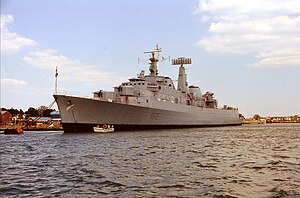 HMS Kent at Portsmouth in 1989
| |
| Class overview | |
|---|---|
| Builders | |
| Operators | |
| Preceded by | Daring class |
| Succeeded by | Type 82 |
| Subclasses |
|
| In commission | 16 November 1962 – 22 September 2006 |
| Completed | 8 |
| Cancelled | 2[1] |
| Laid up | 2 |
| Lost | 0 |
| General characteristics | |
| Type | Destroyer |
| Displacement | 6,200 tons |
| Length | 520 ft (160 m) |
| Beam | 54 ft (16 m) |
| Draught | 21 ft (6.4 m) |
| Propulsion |
|
| Speed | 30 knots (56 km/h; 35 mph) |
| Range | 3,500 nautical miles (6,500 km; 4,000 mi) |
| Complement | 471 (33 officers, 438 ratings) |
| Sensors and processing systems | Type 903 radar (MRS-3 system) |
| Armament |
|
| Aircraft carried | 1× Wessex HAS Mk 3 helicopter |
| Aviation facilities | Flight deck and enclosed hangar for embarking one helicopter |
The County class was a class of British guided missile destroyers, the first such warships built by the Royal Navy. Designed specifically around the Seaslug anti-aircraft missile system, the primary role of these ships was area air defence around the aircraft carrier task force in the nuclear-war environment.[2][3]
Eight ships were built and entered service. Two served in the British naval task force in the Falklands War in 1982. After leaving British service, four ships were sold to the Chilean Navy and one to the Pakistan Navy.
- ^ Brown & Moore (2003).
- ^ Purvis,M.K., 'Post War RN Frigate and Guided Missile Destroyer Design 1944–1969', Transactions, Royal Institution of Naval Architects (RINA), 1974
- ^ Marriott, Leo: Royal Navy Destroyers since 1945, ISBN 0-7110-1817-0, Ian Allan Ltd, 1989